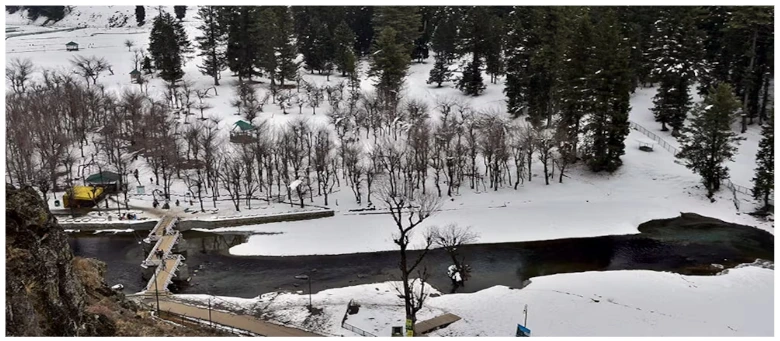Context: Minimum temperatures in several parts of Kashmir have dropped below -3° Celsius, leading to a cold wave in the region.
Kashmir in the grip of ‘Chilla-i-Kalan’
- Chilla-i-Kalan is a local name given to a 40-day harsh winter period in Kashmir. Chilla-i-Kalan will be followed by the 20-day “Chilla-i-Khurd” and the 10-day “Chilla-i-Bachha“.
- Freezing Temperature: Kashmir is currently in the grip of “Chilla-i-Kalan“, when temperatures drop considerably, leading to freezing of water bodies.

- Snowfall: The chances of snowfall are the highest during this period, and most areas, especially the higher reaches, receive heavy snowfall.
Indian Meteorological Organisation (IMD)
- IMD is an agency of the Ministry of Earth Sciences of the Government of India.
- It is the principal government agency in all matters relating to meteorology and allied subjects.
- Vision:
- No cold wave should go undetected and unpredicted.
- Issue of accurate cold wave warning with high spatial resolution and sufficient lead period to enable disaster management and the general public to minimize loss of life and properties.
- Mission:
- To generate and disseminate impact-based forecasts and issue risk-based warnings for cold wave events.
- Cold wave analysis and dissemination of hazard proneness of different country regions.
- Research studies and development of tools to improve the cold wave forecasting and warning services.
|
About Cold Wave
- According to the World Meteorological Organisation (WMO), a cold wave is a period of marked and unusually cold weather characterised by a sharp and significant drop in air temperatures near the surface over a large area and persisting below certain thresholds for at least two consecutive days during the cold season.
- Qualitatively, It is a condition of air temperature which becomes fatal to the human body when exposed.
- Criteria of Cold Wave According to IMD: When the minimum temperature of a station is less than or equal to 10°C for plains and less than or equal to 0°C for hilly regions.
- Based on departure:
- Normal: Negative Departure from normal is 4.5°C to 6.4°C
- Severe Cold Wave: Negative Departure from normal is more than 6.4°C.
- Based on actual Minimum Temperature (for Plains only):
- Normal: When Minimum Temperature is less than or equal to 4.0°C
- Severe Cold Wave: When Minimum Temperature is less than or equal to 2.0°C
- For Coastal Stations: When Minimum Temperature departure is less than or equal to -4.5 °C or actual Minimum Temperature is less than or equal to 15 °C.
Major Factors for Cold Wave Occurrence Over India
- Build up of a ridge (an extended area of relatively high atmospheric pressure) in the jet stream over northwest Asia.
- Formation of surface high-pressure over north & central India.
- Movement of cold air masses in response to steering by upper-level winds.
- Triggering mechanisms like strong westerly waves approaching northwest India to enhance winds for the transport of cold air southeastward.
- Extensive snow covers over the Northwest Himalayas.
Effects of Cold Wave
- Humans: It can lead to hypothermia and other cold-related illnesses, especially among people who are not properly dressed for the cold weather. People with heart problems, older people, and infants are likely to experience increased heart problems, breathing issues, and other issues including deaths, from colder weather.
- According to NCRB, the highest number of human deaths were reported during 2015, which was the deadliest Cold Wave.
- Agriculture: According to IMD, It can also negatively impact agriculture and ecosystems by damaging crops and causing droughts.
News Source: ET
![]() 29 Dec 2023
29 Dec 2023
